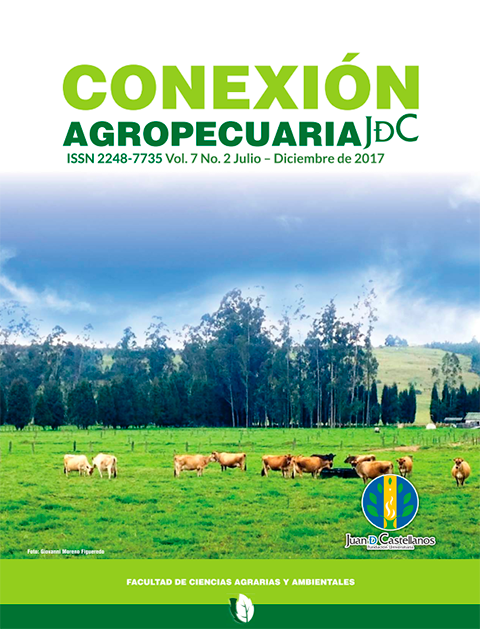Keywords:
bryophytes, bromeliads, reproductive structures, lichens, orchidsAbstract
The phenological expression of epiphytic flora species was monitored on the vegetation cover of Clean Pastures (Cp), Wooded Pastures (Wp), Dense High Flood Forest (Dhff), Gallery Forest and/or Riparian (Gb) - Morichal (M), Secondary High Vegetation (Shv) and Secondary Low Vegetation (Slv), existing in the area of influence of the Plataforma Multipozo Godric Norte 1 project, in the village of Chafurray in the municipality of Puerto Lleras, department of Meta. The main objective was to establish the periods of phenological expression (reproductive structures) and the variation in abundance of the epiphytic species evaluated. For this purpose, four monitoring sessions were carried out, distributed between the months of August and December 2017, and February and June 2018, coinciding with the periods of hydric deficit and increased rainfall. Concerning the variation in abundances, the mortality of an individual of Aechmea angustifolia and two individuals of Aechmea penduliflora André was identified during periods of low rainfall. Regarding phenological expression, fructification and inflorescence were observed for the species Bromelia cf balansae Mez and Aechmea penduliflora André, in the periods with greater precipitation, which indicates that the diversity and abundance of epiphytes respond to the structure of the forest and the availability of water.
Downloads
References
BARTHLOTT, W., MUTKE, J., RAFIQPOOR, M. D., KIER, G., Y KREFT, H. (2005). Global centers of vascular plant diversity. Nova Acta Leopoldina, 92, 61-83.
BENAVIDES, A. M., VASCO, A., DUQUE, A., Y DUIVENVOORDEN, J. F. (2011). Association of vascular epiphytes with landscape units and phorophytes in humid lowland forests of Colombian Amazonia. Journal of Tropical Ecology, 27, 223-237.
BENZING, D.H. (1990). Vascular epiphytes: general biology and related biota. Cambridge: Cambridge University Press.
BRAUN-BLANQUET, J. (1979). Fitosociología. Bases para el estudio de las comunidades vegetales. Barcelona: H. Blume Ediciones.
BRAVO, E. (2007). Los impactos de la explotación petrolera en ecosistemas tropicales y la biodiversidad. Quito: Acción Ecológica.
BRAY, J.R., Y CURTIS, J.T. (1957). An ordination of upland forest communities in the Apostle Islands of Wisconsin. Wilson Bulletin, 72, 156-181.
CALLAWAY, R. M., BROOKER, R. W., CHOLER, P., KIKVIDZE, Z., LORTIE, C. J., et al. (2002). Positive interactions among alpine plants increase with stress. Nature, 417, 844-848.
CRUZ-ANGON, A., Y GREENBERG, R. (2005). Are epiphytes important for birds in coffee plantations? An experimental assessment. Journal of Applied Ecology, 42, 150-159.
CUNNINGHAM, S. A. (2001). Effects of Habitat Fragmentation on the Reproductive Ecology of Four Plant Species in Mallee Woodland, Conservation Biology, 14, 758-768.
ETTER, A., Y ARÈVALO, P. (2014). Escenarios futuros de la cobertura vegetal en Colombia. In: Bello, J. C. (Ed.), Biodiversidad 2014: Reporte de estado de la biodiversidad en Colombia. Instituto A. von Humboldt, Ficha 210.
ETTER, A., ANDRADE, A., SAAVEDRA, K., AMAYA, P., Y ARÉVALO, P. (2017). Estado de los Ecosistemas Colombianos: una aplicación de la metodología de la Lista Roja de Ecosistemas (Vers2.0). Bogotá: Pontificia Universidad Javeriana y Conservación Internacional Colombia.
GARCÍA-FRANCO, J. G., Y TOLEDO-ACEVES, T. (2008). Epífitas vasculares: bromelias y orquídeas. En: Manson R.H., Hernández-Ortiz V., Gallina S. y Mehltreter K. (Eds.), Agrosistema cafetalero de Veracruz: Biodiversidad, manejo y conservación (pp. 69-82).
GENTRY, A. H., Y DODSON, C.H. (1987). Contribution of non-trees to species richnes of tropical rain forest. Biotropica, 19, 149-156.
GRADSTEIN, S.R., NADKAMI, N.M., KROMER, T., HOLZ, I., Y NOSKE, N. (2003). A protocol for rapid and representative sampling of vascular and non-vascular epiphyte diversity in tropical rain forest. Selbyana, 24, 105-111.
GRANADOS-SÁNCHEZ, D., LÓPEZ-RÍOS, G. F., HERNÁNDEZ-GARCÍA, M. Á., Y SÁNCHEZ-GONZÁLEZ, A. (2003). Ecología de las plantas epífitas. Revista Chapingo. Serie Ciencias Forestales y del Ambiente, 9, 101-111.
HUXEL, G. R., Y HASTINGS, A. (1999). Habitat loss, fragmentation and restoration. Restoration Ecology, 7, 309-315.
IDEAM. (2010). Leyenda Nacional de Coberturas de la Tierra. Metodología CORINE Land Cover adaptada para Colombia Escala 1:100.000. Bogotá, D. C.: Instituto de Hidrología, Meteorología y Estudios Ambientales.
INSTITUTO NACIONAL DE LOS RECURSOS NATURALES RENOVABLES-INDERENA. (1977). Resolución Nro. 0213 del 1 de febrero de 1977, “Por la cual se establece la veda para algunas especies y productos de flora silvestre”.
KRÖMER, T., GARCÍA-FRANCO, J. G., Y TOLEDO-ACEVES, T. (2014). Epífitas vasculares como bioindicadores de la calidad forestal: impacto antrópico sobre su diversidad y composición. En: González-Zuarth CA., Vallarino, A., Pérez-Jiménez, JC., Low-Pfeng, AM., Bioindicadores: guardianes de nuestro futuro ambiental (pp. 606-623). Instituto Nacional de Ecología y Cambio Climático (INECC) - El Colegio de la Frontera Sur (ECOSUR).
LAUBE, S., Y ZOTZ, G. (2006). Neither hostspecific nor random: vascular epiphytes on three tree species in a Panamanian lowland forest. Annals of Botany, 97, 1103-1114.
LAGOS, M., Y SÁENZ, F. (2002). Briófitos reófilos del páramo de Mamapacha, Chinavita, Boyacá, Colombia (trabajo de grado). Universidad Pedagógica y Tecnológica de Colombia, Tunja, Colombia.
LINARES, E. L., Y CHURCHLLL, S. P. (1997). Comunidades de briófitos reofílicos en un caño de montaña, en San Francisco, Cundinamarca, Colombia. Caldasia, 19, 143-150.
MAGURRAN, A. (1988). Ecological diversity and its measurement. New Jersey: Princeton University Press.
MCCUNE, B., Y MEFFORD, MJ. (1999). Multivariate analysis of ecological data. Version 4.0. MJM Software Design. 237.
Moreno, C.E. (2001). Métodos para medir la biodiversidad. M&T-Manuales y Tesis SEA, 1(84).
NADKARMI, N., Y MATELSON, T. J. (1989). Bird use of epiphyte resources in neotropical trees. Condor, 91, 891-907.
VIEIRA, E. M., E IZAR, P. (1999). Interactions between aroids and arboreal mammals in the Brazilian Atlantic rainforest. Plant Ecology, 145, 75-82.
VILLAREAL, H., ÁLVAREZ, M., CÓRDOBA, F., FAGUA, G., GAST, F., et al. (2004). Manual de métodos para el desarrollo de inventarios de biodiversidad. Programa de Inventarios de Biodiversidad. Bogotá: Instituto de Investigación de Recursos Biológicos Alexander von Humboldt.
ZOTZ, G., BOGUSCH, W., HIETZ, P., Y KETTELER, N. (2010). Growth of epiphytic bromeliads in a changing world: The effects of CO2, water and nutrient supply. Acta Oecologica, 36, 659-665.





